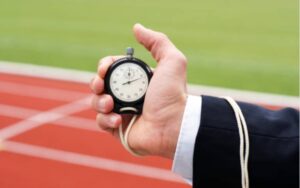
Endurance Running is A Lot Like Sales
Sales and running, at first glance, might seem worlds apart. One involves closing deals and meeting quotas, while the other is about physical endurance and speed. However, these two disciplines share remarkable similarities in terms of mindset, preparation, and execution.
Sales success or “closing a deal” is like winning a 1 mile, 5k, 10k, half-marathon, or a marathon or your age group in a race or better yet the race itself. It is a celebration of endirance, perseverance, and willpower. The culmination of years of dedicated long-distance training, speedwork and the hard work, a grueling yet experienced display of athleticism, I must “always be closing” or always be pushing myself further and faster than I thought possible as I seek my goal.
Though in different arenas, it’s not difficult to notice the similarities between sales and sports. Running is particularly relatable, as it is an activity most of us have participated in at some level at some point in our lives. For example, in sales, like running, you have your winners (i.e. top sales reps) and then everybody else. And of course, most reps have those stretch quota goals that they are working toward. Many of the principles that make a runner an elite athlete hold true for turning sales reps into top performers. Not so sure? Then just keep reading. Here’s how:
Training and Preparation
Both sales and running require rigorous training and preparation. Just as a runner conditions their body through consistent workouts and nutrition, a sales professional hones their skills through ongoing education, role-playing, and studying market trends. This preparation is essential for peak performance, whether on the track or in a boardroom.
Setting Goals
Goal setting is critical in both fields. Runners set specific targets, such as finishing a race in a particular time. Similarly, sales professionals set goals like meeting sales quotas or closing a certain number of deals. These goals provide direction and motivation, driving individuals to push their limits.
Overcoming Obstacles
In running, athletes face physical and mental barriers, such as fatigue and negative thoughts. Salespeople encounter rejection, tough negotiations, and competitive markets. Overcoming these obstacles requires resilience and a positive mindset. Both runners and salespeople must learn to navigate setbacks and remain focused on their end goals.
Consistency and Discipline
Success in running and sales is not achieved overnight. It requires consistent effort and discipline. Runners must adhere to training schedules, while sales professionals need to maintain regular contact with clients and follow up on leads. Consistency in daily routines builds the foundation for long-term success in both areas.
Practice Makes Perfect
If you have never trained before then you are probably not able to go run eight miles at a competitive pace and with no breaks. In order to compete for the win, you need to go out there multiple days a week and do tempo runs, hill repeats, and intervals. Even if your goal is a marathon or to earn a Personal Best in a 5K race, I like to mix it up doing multiple faster, shorter runs as well as slower longer runs every week.
Similarly, sales reps probably aren’t going to sit down, make 10 phone calls, and get 10 meetings. In fact, it takes 7-13 touches on average to make a sale. One will call and email each prospect over a period of time, building that relationship. Sales people trying to hit quota will look to top performers for guidance and work to turn best practices into habits. And like runners, conditioning oneself to be prepared for factors such as temperature and elevation, you also must be prepared to respond to prospect questions and challenges.
Nutrition is Important
All runners understand the importance of proper nutrition and hydration: before-run snacks, replenishment during training, electrolyte replacement, carbo-loading, adjusting calorie intake, the right sources of protein – the list goes on. Like runners need to feed their bodies, sales reps need to feed their minds. Top performing sales reps make sure to stay educated on industry trends, customer challenges, and competitive differences, while also understanding the product that they are selling. It is important that they are knowledgeable enough to engage prospects and add value to the conversation.
Adaptability
Both runners and sales professionals need to adapt to changing conditions. Weather changes can impact a race, just as market conditions can influence sales strategies. Being adaptable and ready to pivot is crucial for maintaining performance levels in varying circumstances.
Driven by Competition
Runners are driven by competition – not just against other athletes but also against themselves, in constant pursuit of setting a new PR (personal record). Similarly, most sales reps are naturally ambitious and thrive in a competitive setting. They look to their colleagues’ successes and strive to do better, which is why gamification has become so popular in recent years. But sales reps, too, compete against themselves, hoping to one-up their own achievements.
Metrics are Key to Tracking Progress and Improving
Runners use a variety of key measures to evaluate the quality of their runs and track progress toward their end goal. Common metrics include minutes per mile, split times, cadence, distance, and heart rate. And of course, sales organizations can improve sales performance and derive value from KPIs such as conversion rates, win rates, marketing collateral usage, average deal size, and deal response time. These data points are essential for any sales team to understand what factors impact successes, how to deliver the right content at the right time, and what changes will improve performance. I know reflecting and evaluating self will only lead you to what you did right, what you did wrong, and how can I do it better keeps you winning and overcoming unexpected surprises.
Innovative Industry
In recent years, the fitness industry has gained attention for its innovative products and processes, from the Paleo diet to barefoot running. And let’s not forget the influx of wearable technologies and smart devices. Over in sales, traditional (and sometimes outdated) strategies have given way to new concepts such as social selling and modern marketing. Reps are no longer giving sales pitches – they are initiating conversations.
As you can see, top sales reps are a lot like elite runners – they put in the time, commitment, and practice to compete and outperform their peers, and they make sure to use the best resources available to them. Completing a marathon is a feat of endurance and stamina, and the same can be said about sales reps hitting their quota. I’ll end with one last analogy. Racing is simply running faster. Similarly, a successful sales rep is just one who sells better with increased productivity and accelerated sales.
The Reward
The sense of accomplishment after crossing a finish line or closing a major deal is unparalleled. Both achievements are the result of hard work, dedication, and perseverance. This reward fuels the passion and commitment needed to continue striving for excellence.
Community and Support
Lastly, the importance of community and support is evident in both fields. Runners often train with clubs or groups, finding motivation and accountability among peers. Sales teams work together, sharing strategies and successes, fostering a collaborative environment that drives everyone forward.
In conclusion, sales is much like running in that it demands preparation, resilience, and a goal-oriented mindset. By embracing these parallels, sales professionals can draw inspiration from the discipline and determination seen in the world of running, ultimately achieving greater success in their careers.
This analogy not only provides a fresh perspective on the sales process but also highlights the universal principles of success that transcend different fields.







